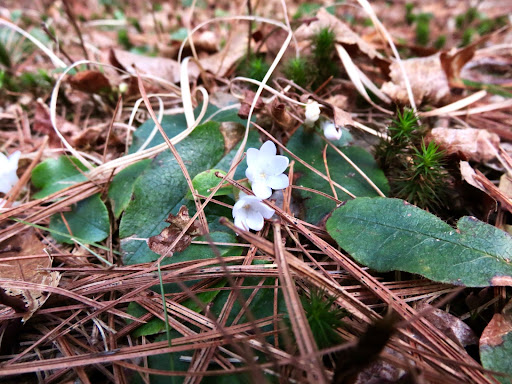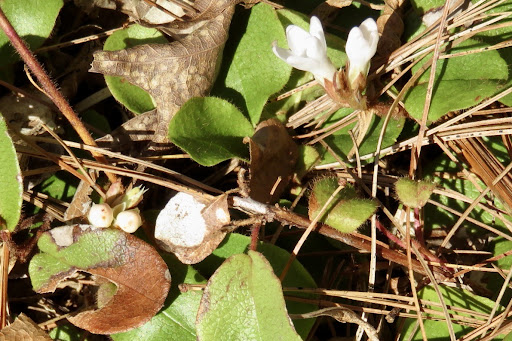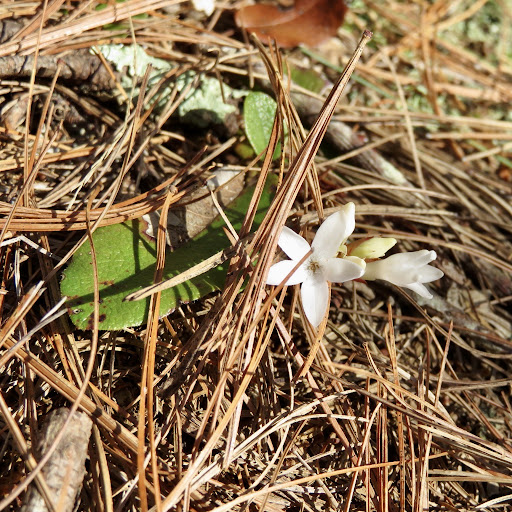We’ve all heard the proverb, “April showers bring May flowers.” Well, it’s mid April, and the “mayflowers” have already begun to bloom. I am referring to a particular flower, the species Epigaea repens, commonly known as trailing arbutus or mayflower. This early-blooming species is a lovely, but humble, shrub that grows only a few inches tall as it creeps along the forest floor.

Mayflower’s leathery, evergreen leaves contrast with the leaf litter of the pine/oak forest, thereby making the plant rather conspicuous. Oval, toothless leaves alternate along hairy stems. Notice the rust-colored hairs on both the stems and leaves in this closeup.

Another attraction for humans is the plant’s sweetly scented flowers. Either white or pink, these little bells have five fused petals. The best way to appreciate their fragrance requires a change in perspective. The Virginia Native Plant Society aptly describes trailing arbutus as a “belly” plant: “one must lie on one’s stomach to catch a legitimate moment of putting eye and nose to the beauty and perfume.”
Not surprisingly, the mayflower’s evergreen leaves and appealing fragrance attracted collectors whose zeal threatened the species’ survival. In response, a group of Boston women formed the Society for the Preservation of New England Flora (now known as the Native Plant Trust) to lobby for its protection. By 1918, mayflower had become the state flower of Massachusetts; soon after, commercial harvesting was prohibited.
Although mayflower is widely distributed across the eastern United States, it is not abundant. It needs acidic, moist, well-drained soil and some sunlight. Look for it in white pine forests, especially along the sloping edges of trails and dirt roads. In such locations, this ground-hugging plant can avoid burial in leaf litter and receive some sunlight. It’s helpful to know that mayflower is a member of the Heath family, a group that includes blueberries, rhododendrons, wintergreen, and cranberries. Some of its habitat requirements overlap with these other heaths, and their presence should remind you to be observant. My photos were taken in pine/oak forests near former cranberry bogs, where blueberries and wintergreen grew nearby.
Despite its ability to thrive in challenging environments, mayflower is vulnerable to disturbances such as lumbering. Enjoy trailing arbutus where it grows; it won’t transplant successfully if collected from the wild. Native plant expert, William Cullina, explains that mayflower grows “out from a central, woody crown that is deep-rooted but easily damaged, and the fine feeder roots that grow along the stems are not enough to support a large plant.” Fortunately, some native plant nurseries propagate and sell trailing arbutus in containers.
As always, “the wild” also needs the plant. As one of the earliest spring blossoms, mayflower provides valuable nectar to bumblebees. It also has a relationship with the ants who disperse its seeds. Go Botany states that ants “. . . carry the soft placental tissue [surrounding the seeds] back to their nests with the seeds attached.” The ants acquire food; the shrub gets planted in an appropriate location. To learn more about the plant’s ecology, read “Mayflower: A Herald of Spring and Our State Flower” at Grow Native Massachusetts.
Now’s the time to be on the lookout for this early bloomer . . . despite its name. Don’t forget to lie down!
